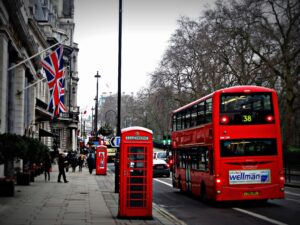A Friendly guide to navigating Britain
Planning a trip to Britain? The land of tea, royal history, and charming countryside awaits you! However, before you pack your bags and head off, there are a few things you should know to make your visit as smooth and enjoyable as possible. From cultural quirks to practical tips, here are five essential things to know before visiting Britain.
1. The Weather: Be Prepared for Anything
When it comes to British weather, one word sums it up perfectly: unpredictable. You might experience sunshine, rain, wind, and possibly even a bit of snow—all in the same day. It’s a common joke among Brits that they can experience all four seasons in a single afternoon. So, how do you prepare for such capricious weather?
What to Pack
- Layers: Bring clothing that you can easily layer. This way, you can add or remove layers as the weather changes.
- Waterproof Gear: A good-quality waterproof jacket and an umbrella are essential. Don’t forget waterproof shoes if you plan on doing a lot of walking.
- Comfortable Footwear: Britain is best explored on foot, so make sure you have comfortable walking shoes.
Embrace the Weather
Instead of letting the weather dictate your plans, embrace it! A rainy day in London is perfect for visiting museums, while a sunny afternoon is ideal for a stroll through one of the many beautiful parks.
2. The Public Transport System: Efficient and Extensive
Britain boasts an extensive and efficient public transport system, especially in cities like London. Understanding how to navigate this system will make your travels much easier.
Trains and Buses
- Oyster Card: If you’re visiting London, get an Oyster card. It’s a prepaid travel card that can be used on buses, trams, the Tube (subway), DLR, London Overground, and some National Rail services.
- National Rail: For traveling between cities, the National Rail service is reliable and covers most of the country. Book tickets in advance for the best prices.
- Buses: Buses are a great way to get around both cities and rural areas. They are usually cheaper than trains and offer a scenic view of the countryside.
Taxis and Ride-Sharing
- Black Cabs: London’s iconic black cabs are convenient but can be pricey. They’re great for short trips or when you’re carrying a lot of luggage.
- Ride-Sharing Apps: Uber and other ride-sharing apps are widely available in most major cities.
3. Currency and Payments: Pounds and Pence
Britain uses the British Pound Sterling (GBP), and it’s important to familiarize yourself with the currency and payment methods.
Currency
- Coins and Notes: British currency consists of coins (1p, 2p, 5p, 10p, 20p, 50p, £1, £2) and notes (£5, £10, £20, £50). Get used to the different sizes and colors to avoid confusion.
- Exchange Rates: Exchange rates can vary, so it’s a good idea to shop around for the best deal if you need to convert your money.
Payments
- Cards: Credit and debit cards are widely accepted. Contactless payment is very common and can be used for purchases up to a certain limit.
- Tipping: Tipping is not as obligatory as in some other countries. In restaurants, a 10-15% tip is customary if the service charge is not included. For taxis, rounding up to the nearest pound is usually sufficient.
4. British Etiquette: Mind Your Manners
Brits are known for their politeness and reserved nature. Understanding a few basic etiquette rules will help you blend in and avoid any social faux pas.
Queuing
- Respect the Queue: Queueing is almost a national pastime in Britain. Whether you’re waiting for a bus or standing in line at the supermarket, always respect the queue. Jumping the line is a major no-no.
Greetings and Conversations
- Polite Greetings: A simple “hello” or “hi” is usually fine. In more formal situations, you might use “good morning,” “good afternoon,” or “good evening.”
- Small Talk: Brits love small talk, especially about the weather. It’s a safe and easy topic to start a conversation.
- Personal Space: Respect personal space and avoid standing too close to others.
Dining Etiquette
- Table Manners: Keep your elbows off the table, chew with your mouth closed, and wait until everyone is served before you start eating.
- Pubs: When in a pub, it’s customary to take turns buying rounds of drinks if you’re with a group. Don’t forget to say “cheers” before taking a sip.
5. Must-See Attractions: Beyond the Classics
While iconic landmarks like Buckingham Palace, the Tower of London, and Big Ben are must-sees, there are plenty of other fantastic attractions to explore.
London
- Camden Market: A vibrant market with unique stalls, street food, and live music.
- Borough Market: Foodies will love this market with its diverse array of food stalls and local produce.
Outside London
- Bath: Known for its Roman baths and stunning Georgian architecture.
- Edinburgh: Scotland’s capital, famous for its historic and cultural attractions, including the Edinburgh Castle and the Royal Mile.
- The Lake District: A region of stunning natural beauty, perfect for hiking and outdoor activities.
Hidden Gems
- Cotswolds: Quaint villages, rolling hills, and charming countryside.
- Cornwall: Beautiful beaches, rugged coastline, and picturesque towns like St. Ives.
Conclusion
Visiting Britain for the first time is an exciting adventure filled with rich history, diverse culture, and breathtaking landscapes. By preparing for the weather, understanding the public transport system, familiarizing yourself with the currency, respecting local etiquette, and exploring both famous and hidden attractions, you’ll ensure your trip is memorable and enjoyable. So, pack your bags, grab your umbrella, and get ready to explore all that Britain has to offer. Cheers to a fantastic journey
